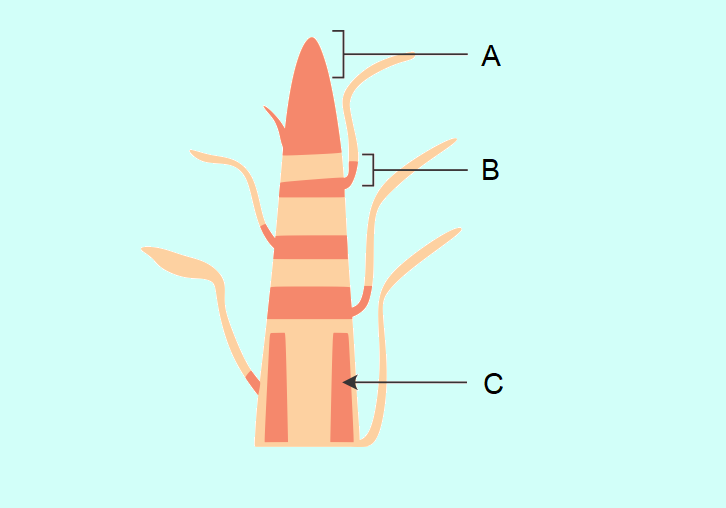MCQs
Protoplasms And Tissues, Cytoplasmic Membrane Systems, Tissues
Total Questions : 143
| Page 2 of 15 pages
Answer: Option A. -> True
:
A
There is no demarcation of dividing and non-dividing regions in animals. Hence, cell growth in animals is more uniform. In plants, growth and active cell multiplication isrestricted to meristematic regions.
:
A
There is no demarcation of dividing and non-dividing regions in animals. Hence, cell growth in animals is more uniform. In plants, growth and active cell multiplication isrestricted to meristematic regions.
Answer: Option C. -> Lignin
:
C
Lignin is present in stems, around vascular bundles, in the veins of leaves and in the hard covering of seeds and nuts. It provides strength to the plant parts.It is largely a supportive structure and is part of the secondary thickening of tall plants. It is a major constituent of woody material. The cells of sclerenchyma are dead, long and narrow because their walls are thickened due to lignin. It acts as a cement and hardens them. Often these walls are so thick that there is no internal space in between the cells.
:
C
Lignin is present in stems, around vascular bundles, in the veins of leaves and in the hard covering of seeds and nuts. It provides strength to the plant parts.It is largely a supportive structure and is part of the secondary thickening of tall plants. It is a major constituent of woody material. The cells of sclerenchyma are dead, long and narrow because their walls are thickened due to lignin. It acts as a cement and hardens them. Often these walls are so thick that there is no internal space in between the cells.
Answer: Option B. -> tissues
:
B
A group of cells having a common origin and co-operating with one another to perform a similar function or a set of similar functions, is described as a tissue. Some examples of tissues are muscular tissues, nervous tissues, meristematic tissues, etc.
:
B
A group of cells having a common origin and co-operating with one another to perform a similar function or a set of similar functions, is described as a tissue. Some examples of tissues are muscular tissues, nervous tissues, meristematic tissues, etc.
Answer: Option C. -> A: Apical meristem
B: Intercalary meristem
C: Lateral meristem
:
C
Apical meristem is present at the growing tips of stems and roots and increases the length of the stem and the root. Lateral meristem is responsible for the increase of girth (width) of the stem or root. Intercalary meristem is present at the base of the leaves or internodes (between two nodes) on twigs.
:
C
Apical meristem is present at the growing tips of stems and roots and increases the length of the stem and the root. Lateral meristem is responsible for the increase of girth (width) of the stem or root. Intercalary meristem is present at the base of the leaves or internodes (between two nodes) on twigs.
Answer: Option A. -> Brain
:
A
The cells of nervous tissue are specialised for receiving stimuli and transmitting messages. Brain, spinal cord and nerves are composed of nervous tissue. The cells of this tissue are called nerve cells or neurons.
:
A
The cells of nervous tissue are specialised for receiving stimuli and transmitting messages. Brain, spinal cord and nerves are composed of nervous tissue. The cells of this tissue are called nerve cells or neurons.
Answer: Option B. -> Phloem
:
B
:
B
- Xylem and phloem are the complex permanent tissues in plants.Phloem is responsible for the movement of food manufactured in leaves to other parts of the plant.
- Xylem is involved in the conduction of minerals and water from roots to the other parts of the plants.
- Cambium (lateral meristem) is situated below the bark and is responsible for the increase in the girth of the stem or root.
- Stomata allow gaseous exchange during photosynthesis and transpiration.
Answer: Option B. -> False
:
B
Neurons are the specialised cellsof the nervous system. Each neuron has a cell body, a long axon and axon terminal. The axons bundle together to form a nerve fibre. Whereas, the muscles are made up of muscular tissue.
:
B
Neurons are the specialised cellsof the nervous system. Each neuron has a cell body, a long axon and axon terminal. The axons bundle together to form a nerve fibre. Whereas, the muscles are made up of muscular tissue.
Answer: Option C. -> glandular epithelium
:
C
A portion of the epithelial tissue folds inward, and forms a multicellular gland. This is called glandular epithelium. This secrete substances at the epithelial surface.
:
C
A portion of the epithelial tissue folds inward, and forms a multicellular gland. This is called glandular epithelium. This secrete substances at the epithelial surface.
Answer: Option A. -> True
:
A
Aerenchyma is a special type of parenchyma tissue present in aquatic plants. They consists of a network of parenchyma cells which enclose large air cavities. These air cavities store gases. This makes the plant light and provides buoyancy.
:
A
Aerenchyma is a special type of parenchyma tissue present in aquatic plants. They consists of a network of parenchyma cells which enclose large air cavities. These air cavities store gases. This makes the plant light and provides buoyancy.

















